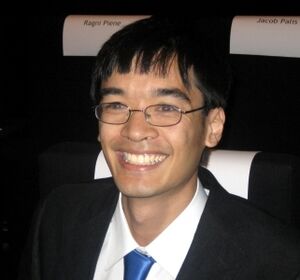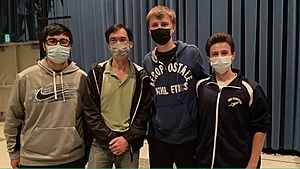Terence Tao facts for kids
Quick facts for kids
Terence Tao
FAA FRS
|
|
|---|---|
 |
|
| Born | 17 July 1975 Adelaide, South Australia, Australia
|
| Citizenship |
|
| Education |
|
| Known for | Partial differential equations, analytic number theory, random matrices, compressed sensing, combinatorics, dynamical systems |
| Spouse(s) | Laura Tao |
| Children | 2 |
| Awards | Fields Medal (2006)
List
Salem Prize (2000)
Bôcher Memorial Prize (2002) Clay Research Award (2003) Australian Mathematical Society Medal (2005) Ostrowski Prize (2005) Levi L. Conant Prize (2005) MacArthur Award (2006) SASTRA Ramanujan Prize (2006) Sloan Fellowship (2006) Fellow of the Royal Society (2007) Alan T. Waterman Award (2008) Onsager Medal (2008) King Faisal International Prize (2010) Nemmers Prize in Mathematics (2010) Pólya Prize (2010) Crafoord Prize (2012) Simons Investigator (2012) Breakthrough Prize in Mathematics (2014) Royal Medal (2014) PROSE Award (2015) Riemann Prize (2019) Princess of Asturias Award (2020) Bolyai Prize (2020) IEEE Jack S. Kilby Signal Processing Medal (2021) Global Australian of the Year Award (2022) Grande Médaille (2023) Best Paper Award (2023) Alexanderson Award (2023) |
| Scientific career | |
| Fields | Harmonic analysis |
| Institutions | University of California, Los Angeles |
| Thesis | Three Regularity Results in Harmonic Analysis (1996) |
| Doctoral advisor | Elias M. Stein |
| Doctoral students | Monica Vișan |
| Terence Tao | |||||||||||||||||||||
|---|---|---|---|---|---|---|---|---|---|---|---|---|---|---|---|---|---|---|---|---|---|
| Traditional Chinese | 陶哲軒 | ||||||||||||||||||||
| Simplified Chinese | 陶哲轩 | ||||||||||||||||||||
|
|||||||||||||||||||||
Terence Chi-Shen Tao (born 17 July 1975) is an amazing Australian-American mathematician. He is a professor of mathematics at the University of California, Los Angeles (UCLA). Many people consider him one of the greatest living mathematicians.
Tao has done a lot of research in different areas of math. These include harmonic analysis, partial differential equations, and analytic number theory. He won the famous Fields Medal in 2006. He also received the Royal Medal and the Breakthrough Prize in Mathematics in 2014.
Contents
Life and Career Highlights
Terence Tao's Family Background
Terence Tao's parents moved to Australia from Hong Kong. His father, Billy Tao, was a children's doctor. His mother, Grace Leong, was a math and physics teacher. Both of his parents studied at the University of Hong Kong.
Terence has two brothers, Trevor and Nigel. They also represented Australia in the International Mathematical Olympiad. Trevor is also a Chess International Master. Terence is married to Laura Tao, who is an electrical engineer. They live in Los Angeles, California, and have two children.
Terence Tao's Childhood as a Math Whiz
Terence Tao was a true child prodigy. He showed incredible math skills from a very young age. He even skipped five grades in school. By the age of nine, he was already taking university-level math classes.
He was one of only three children in a special program for talented students to score over 700 on the SAT math section at just eight years old. Terence scored a 760! He was the youngest person ever to compete in the International Mathematical Olympiad. He won a bronze medal at age ten, silver at eleven, and a gold medal at thirteen in 1988.
Terence Tao's Professional Journey
At 14, Tao attended a summer program for high school students interested in science. He earned his bachelor's and master's degrees from Flinders University at age 16. In 1992, he received a scholarship to study math at Princeton University in the United States.
He earned his PhD at 21. In 1996, he joined the faculty at the University of California, Los Angeles. By 1999, at just 24, he became a full professor at UCLA. He is the youngest person ever to achieve this rank there.
Tao is known for working with many other mathematicians. By 2015, he had worked with 68 co-authors on his discoveries. He worked closely with British mathematician Ben J. Green. Together, they proved the Green–Tao theorem. This theorem shows that you can find very long sequences of prime numbers that are equally spaced out.
For example, 3, 7, and 11 are prime numbers with a spacing of 4. The Green-Tao theorem says you can always find such sequences of any length, no matter how long.
Tao has also solved or made progress on many other big math problems. These include:
- His work on a modified version of the Navier–Stokes equations.
- Solving the Erdős discrepancy problem in 2015.
- Making progress on the Collatz conjecture in 2019.
Terence Tao's Awards and Recognition
Terence Tao has received many important awards for his math work. In 2006, he won the Fields Medal. This is considered the highest award a mathematician can receive. He was the first Australian and the first UCLA professor to win it. He also received the MacArthur Award.
He has been featured in many news outlets like The New York Times and CNN. In 2014, he received an award from Johns Hopkins Center for Gifted and Talented Youth. In 2021, he was chosen to be part of the U.S. President's Council of Advisors on Science and Technology.
As of 2022, Tao had published over three hundred articles and sixteen books. Other mathematicians often ask him for help with their difficult problems. They say he is like a "Mr. Fix-it" for researchers who are stuck.
A famous mathematician named Timothy Gowers said that Tao knows an amazing amount about many different areas of math. He can write about complex topics like partial differential equations and quantum mechanics. It's a mystery how he knows so much and still writes so many papers and books!
Key Research Areas
Understanding Equations of Motion
From 2001 to 2010, Tao worked with other mathematicians on partial differential equations. These equations describe how things change over time and space. They found new ways to understand equations like the Schrödinger equation and KdV equations. Their work helped show when these equations have stable solutions.
In 2016, Tao created a new version of the Navier–Stokes equations. These equations are used to describe how fluids move. His work showed that solving the original Navier-Stokes problem is very complex.
Compressed Sensing and Data Analysis
Tao has also made big contributions to compressed sensing. This field is about taking a small amount of data and using it to reconstruct a full picture or signal. Imagine taking just a few pixels from an image and being able to recreate the whole thing!
He worked with Emmanuel Candes and Justin Romberg on this. Their work helps find the simplest possible solution to problems with missing information. This is very useful in areas like medical imaging and signal processing.
Random Matrices and Their Properties
Tao has also studied random matrices. These are grids of numbers where each number is chosen randomly. He and Van Vu made a big discovery in 2010 about how the "eigenvalues" (special numbers related to the matrix) of non-symmetric random matrices are spread out.
They proved the "circular law." This law says that if you pick numbers randomly for a matrix, its eigenvalues will tend to be evenly scattered in a circle. This helps us understand complex systems where randomness plays a role.
Prime Numbers and Number Patterns
In 2004, Tao worked with Jean Bourgain and Nets Katz to study numbers in finite fields. They showed that if you take a group of numbers in such a field, the number of possible sums and products you can make from them will be very large.
One of Tao's most famous achievements is the Green–Tao theorem. He proved this with Ben Green. It states that there are infinitely many arithmetic progressions of prime numbers. An arithmetic progression is a sequence of numbers where the difference between consecutive terms is constant (like 3, 7, 11, where the difference is 4). This was a huge step forward in understanding prime numbers.
Notable Awards and Honors
Terence Tao has received many awards for his work in mathematics.
- 1999 – Packard Fellowship
- 2000 – Salem Prize
- 2002 – Bôcher Memorial Prize
- 2003 – Clay Research Award
- 2005 – Australian Mathematical Society Medal
- 2005 – Ostrowski Prize (with Ben Green)
- 2005 – Levi L.Conant Prize (with Allen Knutson)
- 2006 – Fields Medal (the highest award in mathematics)
- 2006 – MacArthur Award
- 2006 – SASTRA Ramanujan Prize
- 2006 – Sloan Fellowship
- 2007 – Fellow of the Royal Society
- 2008 – Alan T. Waterman Award
- 2008 – Onsager Medal
- 2009 – Inducted into the American Academy of Arts and Sciences
- 2010 – King Faisal International Prize
- 2010 – Nemmers Prize in Mathematics
- 2010 – Polya Prize (with Emmanuel Candès)
- 2012 – Crafoord Prize
- 2012 – Simons Investigator
- 2014 – Breakthrough Prize in Mathematics
- 2014 – Royal Medal
- 2015 – PROSE award for his book "Hilbert's Fifth Problem and Related Topics"
- 2019 – Riemann Prize
- 2019 – The Carnegie Corporation of New York honored Tao with a Great Immigrants Award
- 2020 – Princess of Asturias Award for Technical and Scientific Research (with Emmanuel Candès)
- 2020 – Bolyai Prize
- 2021 – IEEE Jack S. Kilby Signal Processing Medal
- 2022 – Global Australian of the Year (Advance Global Australians; Advance.org)
- 2022 – Grande Médaille
- 2023 – Alexanderson Award
Images for kids
-
Tao at the age of 10 with mathematician Paul Erdős in 1985
See also
 In Spanish: Terence Tao para niños
In Spanish: Terence Tao para niños
- Cramer conjecture
- Erdős discrepancy problem
- Goldbach's weak conjecture
- Inscribed square problem




